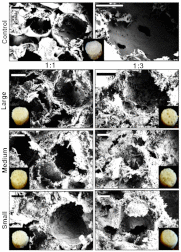High-strength silk protein scaffolds for bone repair
- PMID: 22552231
- PMCID: PMC3356671
- DOI: 10.1073/pnas.1119474109
High-strength silk protein scaffolds for bone repair
Abstract
Biomaterials for bone tissue regeneration represent a major focus of orthopedic research. However, only a handful of polymeric biomaterials are utilized today because of their failure to address critical issues like compressive strength for load-bearing bone grafts. In this study development of a high compressive strength (~13 MPa hydrated state) polymeric bone composite materials is reported, based on silk protein-protein interfacial bonding. Micron-sized silk fibers (10-600 µm) obtained utilizing alkali hydrolysis were used as reinforcement in a compact fiber composite with tunable compressive strength, surface roughness, and porosity based on the fiber length included. A combination of surface roughness, porosity, and scaffold stiffness favored human bone marrow-derived mesenchymal stem cell differentiation toward bone-like tissue in vitro based on biochemical and gene expression for bone markers. Further, minimal in vivo immunomodulatory responses suggested compatibility of the fabricated silk-fiber-reinforced composite matrices for bone engineering applications.
Conflict of interest statement
The authors declare no conflict of interest.
Figures





Similar articles
-
High strength silk protein scaffolds: the future of spinal fusions.Neurosurgery. 2012 Aug;71(2):N29-30. doi: 10.1227/01.neu.0000417541.38365.a2. Neurosurgery. 2012. PMID: 22811208 No abstract available.
-
Silk as a biocohesive sacrificial binder in the fabrication of hydroxyapatite load bearing scaffolds.Biomaterials. 2014 Aug;35(25):6941-53. doi: 10.1016/j.biomaterials.2014.05.013. Epub 2014 May 29. Biomaterials. 2014. PMID: 24881027 Free PMC article.
-
Silk fiber reinforcement modulates in vitro chondrogenesis in 3D composite scaffolds.Biomed Mater. 2017 Jul 24;12(4):045012. doi: 10.1088/1748-605X/aa7697. Biomed Mater. 2017. PMID: 28737162
-
Silk scaffolds in bone tissue engineering: An overview.Acta Biomater. 2017 Nov;63:1-17. doi: 10.1016/j.actbio.2017.09.027. Epub 2017 Sep 20. Acta Biomater. 2017. PMID: 28941652 Review.
-
Oral Bone Tissue Regeneration: Mesenchymal Stem Cells, Secretome, and Biomaterials.Int J Mol Sci. 2021 May 15;22(10):5236. doi: 10.3390/ijms22105236. Int J Mol Sci. 2021. PMID: 34063438 Free PMC article. Review.
Cited by
-
Development of Injectable Citrate-Based Bioadhesive Bone Implants.J Mater Chem B. 2015 Jan 21;3:387-398. doi: 10.1039/C4TB01498G. J Mater Chem B. 2015. PMID: 25580247 Free PMC article.
-
Quantitative characterization of mineralized silk film remodeling during long-term osteoblast-osteoclast co-culture.Biomaterials. 2014 Apr;35(12):3794-802. doi: 10.1016/j.biomaterials.2014.01.034. Epub 2014 Jan 29. Biomaterials. 2014. PMID: 24484674 Free PMC article.
-
Biomaterials in tooth tissue engineering: a review.J Clin Diagn Res. 2014 Jan;8(1):309-15. doi: 10.7860/JCDR/2014/7609.3937. Epub 2014 Jan 12. J Clin Diagn Res. 2014. PMID: 24596804 Free PMC article.
-
Silk microfiber-reinforced silk hydrogel composites for functional cartilage tissue repair.Acta Biomater. 2015 Jan;11:27-36. doi: 10.1016/j.actbio.2014.09.032. Epub 2014 Oct 2. Acta Biomater. 2015. PMID: 25281788 Free PMC article.
-
Engineering Silk Materials: From Natural Spinning to Artificial Processing.Appl Phys Rev. 2020 Mar;7(1):011313. doi: 10.1063/1.5091442. Epub 2020 Feb 26. Appl Phys Rev. 2020. PMID: 34367402 Free PMC article.
References
-
- Drosse I. Tissue engineering for bone defect healing: An update on a multi-component approach. Injury. 2008;39(Suppl 2):S9–S20. - PubMed
-
- Langer R, Vacanti JP. Tissue engineering. Science. 1993;260:920–926. - PubMed
-
- Marquis ME, et al. Bone cells biomaterials interactions. Front Biosci. 2009;14:1023–1067. - PubMed
-
- Khan Y, Yaszemski MJ, Mikos AG, Laurencin CT. Tissue engineering of bone: Material and matrix considerations. J Bone Joint Surg Am. 2008;90:36–42. - PubMed
-
- Dawson JI, et al. Development of specific collagen scaffolds to support the osteogenic and chondrogenic differentiation of human bone marrow stromal cells. Biomaterials. 2008;29:3105–3116. - PubMed
Publication types
MeSH terms
Substances
Grants and funding
LinkOut - more resources
Full Text Sources
Other Literature Sources

